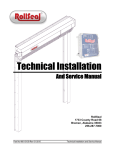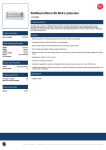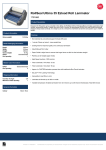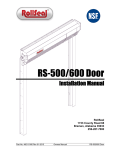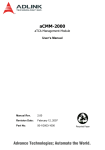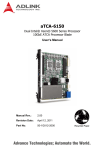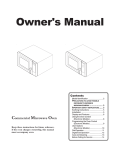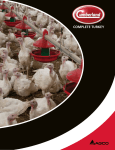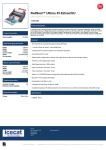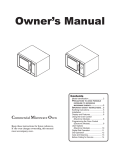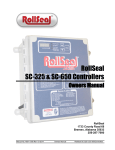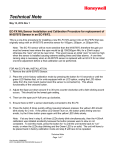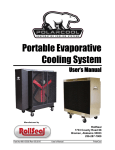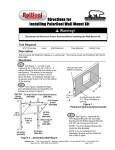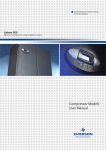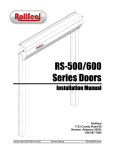Download RS-600 Door Installation Manual
Transcript
Technical Installation and Service Manual RollSeal 1733 County Road 68 Bremen, Alabama 35033 4801-5159 rev. 05/14 Technical Installation and Service Manual Page 1 of 26 1. Ratings and Specifications • • • Motor Rating………..240 VAC, Three Phase, 1/4 hp Door approved by the NSF (National Sanitation Foundation) Motor must be connected through controller. See SC-325 Manual (4801-5156). E 14-1/8 in. (35.9 cm.) 5 3/4 in. (14.6 cm.) Space for access door removal B C A D TABLE 1 RS 500 Door Standard Dimensions: WIDTH Related Dimensions A HEIGHT Related Dimensions D E RS500 Door Width Ft. In. cm Ft. In. cm Ft. In. cm 4'(W) 4 0 122 5 4-13/32 164 6 8-15/16 206 RS500 Door Height B C Ft. In. cm Ft. In. cm 7'(H) 7 0 214 8 8-11/16 266 7 6 229 9 2-11/16 281 5'(W) 5 0 153 6 4-13/32 194 7 8-15/16 236 7'6"(H) 6'(W) 6 0 183 7 4-13/32 225 8 8-15/16 267 8'(H) 8 0 244 9 8-11/16 296 6'6"(W) 6 6 198 7 10-13/23 240 9 2-15/16 282 9'(H) 9 0 275 10 8-11/16 327 7'(W) 7 0 214 8 4-13/32 255 9 8-15/16 297 10'(H) 10 0 305 11 8-11/16 357 11 0 335 12 8-11/16 387 12 0 366 13 8-11/16 418 8'(W) 8 0 244 9 4-13/32 286 10 8-15/16 328 11'(H) 10'(W) 10 0 305 11 4-13/32 347 12 8-15/16 388 12'(H) 11'(W) 11 0 335 12 4-13/32 377 13 8-15/16 419 12'(W) 12 0 366 13 4-13/32 408 14 8-15/16 449 4801-5159 rev. 05/14 Technical Installation and Service Manual Page 2 of 26 2. Physical Description/Drawing Installation of a RollSeal RS-500 Automatic Door involves, at a minimum, connecting to the Smart Controller (SC)-325 that connects to the AC power, the door motor, the Up/Down button, and the safety beam. Other accessories can be added such as a remote IR sensor, a remote radio link, and door movement indicators such as lights and bells. Motor (240 VAC - 3 phase) Control Box Limit switches are located within the interior of horizontal member. See Section 8 for description of limit switches. The RS500 Door requires a SC-325 Controller. Safety beams Floating Magnets and Laminated Steel (Attached to outside of curtain and inside track units) Tension pipes are located within folds of curtain. 3. Use of Equipment The RollSeal RS-500-Door is an automatic motorized curtain enclosure for a doorway. 4. Installation 4.1 Tools Required 3/8 in. (10 mm) Power screwdriver (portable) 3/16 in. (5 mm) Drill bit and power drill 3/8 x 1 in. Bolts and nuts (supplied) Socket Hammer Tape measure Carpenter's level NOTE: Other Tools May Be Required According To Installation. 4.2 Overview The RS-500-door is shipped with pre-assembled vertical members (left track and right track), and a preassembled horizontal member (head unit). Identify components by the Parts/Assemblies section in back of this manual. When components are received, check for damaged or loose or missing parts. If there are damaged or missing parts contact your RollSeal distributor immediately. Please read and understand all instructions in this manual before beginning installation. 4801-5159 rev. 05/14 Technical Installation and Service Manual Page 3 of 26 4.3 Adjusting the Clear Opening Locate your particular system in Table 1, page 1. Read the value of height and width of the clear opening for the door size that you are installing. This gives the required dimensions of the clear opening. If necessary, adjust the dimensions of the mounting posts or framing members to the height and width of your RS-500 door system as shown in Diagram 1. Refer to Section 4.4 (page 4, Diagram 2) for details of attaching door to framing members. Framing material must provide suitable support for attachment of screws. Make sure that mounting posts or framing members are positioned so that the screw holes of the outer flanges of the vertical members will align with the mounting posts or framing members (Section 6.4, page 8, Diagram 2). Make sure that there is room for the motor and control box without encountering any obstructions. Diagram 1 Front View (Curtain Side) 5.75 in. (14.61 cm.) 4.125 in. (10.45 cm.) 20.688 in (52.55 cm.) Overall height =Height + 20.688 in. (52.55 cm.) 10 in. (25.40 cm.) Space for access door removal. Width (see Table 1 Page 1) Height (see Table 1 Page 1) Floor Level 8.2 in. (20.83 cm.) Overall Width = Width + 16.4 in. (41.66 cm.) NOTE: Allow 1' (30.4 cm) minimum, preferably 18" (45.7 cm) clearance above the Head Unit for future panel maintenance or replacement. 4801-5159 rev. 05/14 Technical Installation and Service Manual Page 4 of 26 4.4 Attachment Points of Door 1. When sizing the clear opening for attachment of the door, pay close attention to the following guidelines. Door flanges have pre-drilled holes that serve as mounting points of door. Flange widths are shown in Diagram 2. Make sure that door assembly is plumb & square. 2. The top unit has a top flange and a bottom flange. Make sure these flanges overlap framing. 3. The vertical members have inner flanges and outer flanges. The outer flanges have pre-drilled holes that serve as attachment points. Make sure the outer flanges overlap framing. 4. When door is raised in front of clear opening (Section 4.7, page 6), Diagram flanges must be flush against framing for attachment of screws. 1 in. (2.54 cm.) Diagram 2 A Holes in top flange are pre-drilled. 1 in. (2.54 cm.) Pre-drilled holes for flange attachment A Holes in outer flange are pre-drilled. Section A-A Framing Members 1.25 in. (3.17 cm) Outer flange Bottom View 1.25 in. (3.17 cm.) Inner flange Framing Members 4801-5159 rev. 05/14 Technical Installation and Service Manual Page 5 of 26 4.5 Assembly of Parts Arrange the horizontal member, left vertical member (left track), and right vertical member (right track) on the floor in front of the clear opening as shown in Diagram 3. The curtain side of the horizontal member and each vertical member faces down. A End of horizontal member B U-shaped plate On each end of the horizontal member is a U-shaped plate that fits inside each vertical member. The Ushaped plate has four bolt holes, two on the inside and two on the outside flanges that match bolt holes in the vertical member. See diagram at left. 1. Align the vertical member with the U-shaped metal plate at end of horizontal member. 2. Slide the vertical member onto the outside of the U-shaped metal plate of the horizontal member as shown in A. 3. Insert bolts through bolt holes as shown in B. Install nuts. Tighten bolts & nuts securely. 3/8" x 1" Bolts & nuts Plate fits inside vertical member Slide vertical member over U-shaped plate. Vertical Member Right vertical member Clear Opening At this end of members Diagram 3 Left vertical member Placement of Parts for Assembly Lay left track, right track, and horizontal member face down in front of the clear opening as shown. Horizontal member 4801-5159 rev. 05/14 Technical Installation and Service Manual Page 6 of 26 4.6 Infrared Sensor Connectors Located at the bottom of each vertical member is an infrared detector. The detector on each vertical member operates as a safety device if the infrared beam is interrupted. Door can be set to stop if beams are broken while closing or to stop and reverse to the full open position. Refer to the RollSeal SC-325 Controller Manual for more information. 1. Locate female connector on vertical member. This connector is attached to the infrared detector. 2. Locate male connector on horizontal member. Unroll cable until connectors meet. 3. Plug connectors together. Make sure connectors interlock. 4. Repeat for both infrared detectors. 5. Cable ties and adhesive mounts are supplied to secure wire to the inside of tracks. Diagram 4 NOTE: For each vertical member, unroll respective sensor cable attached to horizontal member until cable reaches the connector attached to the vertical member. Plug connectors together. Some slack must be left at photo eyes for replacement purposes. 4.7 Fastening Door Assembly to Clear Opening The two diagonals must be within 1/8 inch. 1. Use a tape measure and make sure that the overall height and overall width of the clear opening meet the requirements: Overall Height = Height + 20.688 in. (52.55 cm), Overall Width = Width + 16.4 in. (41.66 cm). Reference Table 1 and Diagram 1. 2. Make sure that door assembly is plumb & square. See Diagram 5. Verify dimensions from Table 1. Diagram 5 4801-5159 rev. 05/14 Technical Installation and Service Manual Page 7 of 26 3. Center door assembly on clear opening. Align the bottom of each vertical member with the respective framing board or posts of the clear opening. NOTE: The vertical members should be aligned so that their outer flanges will exactly overlap with the framing boards or posts when the door assembly is raised into position. 4. Assemble workers and equipment into position on each side of the door assembly. IMPORTANT: SLOWLY LIFT TOP OF DOOR ASSEMBLY TO RAISE THE DOOR. See Diagram 6. Diagram 6 Drill 1/4" Hole and Install Hammer Set Anchors Diagram 7 5. Lean door assembly upright against clear opening. 6. Carefully press flanges of the door assembly flush against faces of framing boards or posts. 7. Fasten Tek screws (in steel) or lag screws (in wood) through the flanges on sides of door assembly. Securely tighten all screws. 8. On the lower and upper flanges of the horizontal member there are attachment points for fastening screws. Fasten Tek screws (in steel) or lag screws (in wood) 4801-5159 rev. 05/14 through the holes. This secures the top of the door to the clear opening. 9. Locate the two floor mounting holes at the bottom of the left & right tracks. See Diagram 7. 10. Drill a 1/4" hole and install Hammer Set Anchors (1002-6030) in both right and left tracks. See Diagram 7. 11. This completes fastening of the door assembly to the clear opening. 12. Refer to controller section for the next steps. Technical Installation and Service Manual Page 8 of 26 5. Typical Smart Controller Installation A typical installation of the Smart Controllers involve, at a minimum, connections to AC Power, the door motor, the Up/Down button, and the Safety Beam. Other accessories can be added such as a remote IR sensor, a remote radio link, and door movement indicators such as lights and bells. Control Box and Encoder Assembly IR Detector Limit and Safety Switches are located within the interior of horizontal member. Drive Motor RS-500 or RS-600 Door SC-325 or SC-650 Brake Release Tension Pipes Safety Beam Input Power 4801-5159 rev. 05/14 Technical Installation and Service Manual Page 9 of 26 6 Controller Installation and Setup 6.1 Tools Required Small screwdriver 6.2 Standard Screwdriver Wire strippers Installation Instructions 1. Unpack system, and check that all components are present. 1 RollSeal Smart Controller 1 Installation Kit 1 Manual 2. Hang the controller with four screws at the desired location. 3. Make sure all power supplies are disconnected before breaking any wires, or reaching into the controller enclosure. 4. Determine the required Powering Voltage whether 115 VAC or 230 VAC. 5. If the desired power supply voltage is different from the factory preset/prewired voltage, the appropriate version Brake Rectifer must be ordered separately, field-installed on the RS Door, and the SC controller switch & jumper settings changed accordingly. The SC-325 controllers are factory preset to 115 VAC and the RS-500 doors factory prewired to require a 115 VAC power supply. The SC-650 controllers are factory preset to 230 VAC and the RS-600 doors factory prewired to require a 230 VAC power supply. The SC-325/SC-650 controllers and RS-500/600 doors can be field upgraded to accommodate either 115 VAC or 230 VAC power supply. Refer to Section 12.5 for the SC controller power wiring, switch setting, and jumper setting and Section 12.6 for the Motor Brake Rectifier part numbers and wiring information. WARNING! Only a qualified electrician should install and/or service this equipment. Failure to observe precautions could result in equipment damage, severe bodily injury, or loss of life. WARNING! Dangerous High Voltages! Allow Approximately 5 Minutes For The Controller To Power-Down Before Changing Switch Settings, Jumper Placement, Or Wiring. 6. Connect power. 7. Connect AC/DC harness hook up. See diagram 8 on page 16 8. Turn the controller on. 9. Set the Open and Closed Speed and Limits, the Acceleration and Deceleration Ranges, Close Time Delay and Switch positions as discussed in Section 5 of this manual. 10. Refer to door setup guide for next step. (see page 13) 4801-5159 rev. 05/14 Technical Installation and Service Manual Page 10 of 26 7. Connecting Power to the SC-325 Controller WARNING! WARNING! Ensure the Drive AC Selection Jumper and PCB 154 AC Selection Switch Are Set Accordingly BEFORE Power Is Applied To The Controller 4801-5159 rev. 05/14 Hardwire Facility Power As Required, Either 120 V or 240 V. Set Jumper And Selection Switch Accordingly Technical Installation and Service Manual Page 11 of 26 7.1 Connecting Switches to the SC-325 Wiring Option “-W01” Controller PN 6607-8057 and 6607-8058 W R N I N 9.1 Orange Wires Must Be Capped Off If Not Used With A Freezer door Note All conduit and/or air spaces where wire is routed must be airtight. Use sealant if necessary Note Recommend Using 18 Gauge For Switch Wiring 4801-5159 rev. 05/14 Technical Installation and Service Manual Page 12 of 26 8. Door Setup Guide Note: DO NOT USE JOG Mode to do these tests 1. Press and hold the ‘MODE’ Button until P1 is shown in the display. Set P1 to 45 seconds for the ‘Time Out’ function. 2. Press the ‘MODE’ button 1 time to P2. Set P2 to 20 3. Press the ‘MODE’ button 1 time to P3. Set P3 to 80 4. Press the ‘MODE’ button 1 time to P4. Set P4 to 3 (Note: This must be 3 for freezer CMS Box to heat and blow air. 5. Press the ‘MODE’ button 1 time to P5. Set P5 to 25 6. Press the ‘MODE’ button 1 time to P6. Set P6 to 5 7. Press the ‘MODE’ button 1 time to P7. Set P7 to 25 8. Slowly press the ‘MODE’ button skipping P10, P11, and P12 until you see PS1 in the display. It will indicate ‘no’ on the screen. Hit the up arrow on the controller to change ‘no’ to ‘yes.’ This is where you will begin to set the upper and lower limits of the door panel (fabric). Hit the ‘MODE’ button again and the panel will move towards the HOME switch and then back down towards the current setting of the OPEN limit. Use the up and down arrows to set the upper limit between 20-24 in the display. Then press the ‘MODE’ button again and the panel will move downwards toward the current CLOSE limit. Use the up and down arrows to achieve the proper lower limit and ensure that the panel is resting firmly against the floor to create a good seal (especially important for Freezer doors). If the door closes to the floor on the first attempt, press the up arrow to bring the panel slightly off the floor and then press the down arrow to achieve this seal. This will prevent slack in the panel which could result in the panel auto reversing when it hits the floor. The number displayed will then become your lower limit. 9. Press the ‘MODE’ button one last time to exit programming mode. Your lower limit that was just set will remain in the display and you will have the green LED on the controller lit up beside ‘ACTUAL POSITION.’ 4801-5159 rev. 05/14 Technical Installation and Service Manual Page 13 of 26 9. Troubleshooting Flowchart Looking at the SC-325 or SC-650 display, what is being displayed? Three Dashes (---) Unknown position indication, See article 1 Alternates between three dashes (---) and a numerical (718) l ii Press an open button to reset the actual position Check egress strap to ensure that the strap is in the correct reset Limit Mark position and not pulled out of position. Yes Error Code A numerical actual position, (718) See article 2 Has the SWX2 selection switch & drive selection jumper been set to match incoming voltage? Yes Will the door run in jog mode? No No Is the power LED on the motor drive board steady Yes No Set switch and jumper then restart flow chart. 4801-5159 rev. 05/14 Check incoming voltage at L1-L2 to motor drive board. If present replace drive board, if not check incoming supply. Technical Installation and Service Manual Page 14 of 26 Is the obstruction LED on in the display? When does the obstructio n LED Yes While Opened While Closing Is any item or door panel between door safety Remove item or correct door panel. Yes No No Adjust the lead edge switch, see article 6. Yes Remove terminals for direction and sequential on door assembly. Does the door move in either Will the obstruction LED go out while activating the lead edge Yes Replace control door assembly Adjust the lead edge switch, see article 6. No No Perform test in article 5. Does door operate properly? Problem is in Accessory switches added to the door Check for short in lead edge circuit, if all ok then replace control door assembly. Yes No When trying to jog door, what is the status of ST LED? See article 4. 4801-5159 rev. 05/14 Replace control door assembly. Technical Installation and Service Manual Page 15 of 26 10. Unknown Position Indication There are occasions when the controller may not know the exact position of the door, for example, when returning from the Jog Mode. In these cases the Display Indicator will display a series of three bars as shown at the right. This is known as the Unknown Position Indication. When the door is actuated, the door will proceed to the full open position, however the speed of the door will be reduced. When the door has returned from the home switch position to the open limit position, the display will show the actual position of the door. This indicates that the door has reset its position and is ready for normal operation. If something in the door encoders fails the control will not be able to recognize the position of the door. This problem can also arise from a loose or bad connection in the DC harness. Check to make sure the harness is connected properly and that there aren’t any loose wires in the connections of the encoders. Diagram 8 Lead Edge Switch Safety Switch Home Switch Control Box DC Plug AC Plug Encoder DC Harness 4801-5159 rev. 05/14 Technical Installation and Service Manual Page 16 of 26 11. Error Codes Mechanical Errors Code EO1 Condition Opening, Home Switch EC1 Closing, Home Switch Home Switch EO2 Opening, Safety Switch Safety Switch EC2 Closing, Safety Switch Safety Switch EO3 Opening, Safety Switch Home & Safety EC3 Closing, Safety Switch Home & Safety 4801-5159 rev. 05/14 Panel Movement Problem Area Home Switch Possible Solutions Try to activate door normally (open), should fix itself Use JOG mode to lower door panel below Home switch, See Article 3 Manually release brake and pull panel below Home switch, See figure 1 Home Switch Arm may be loose. Retighten, See Article 6 Lower limit is not set correctly, Reset door limits PS 1 Home Switch Arm may be loose. Retighten, See Article 6 Faulty connections, check DC harness (Grey Cable) at the door and the DC connections on the PCB154 See figure 2 & 3 Safety Switch Arm may be loose.Retighten, See Article 6 Faulty connections, check DC harness (Grey Cable) at the door and the DC connections on the PCB154 See figure 2 & 3 Safety Switch Arm may be loose.Retighten, See Article 6 Faulty connections, check DC harness (Grey Cable) at the door and the DC connections on the PCB154 See figure 2 & 3 Manually release brake and pull panel below Home switch, See figure 1 Check DC harness connection, especially if "Door Obstruction" LED is on. See figure 2. Manually release brake and pull panel below Home switch Check DC harness connection, especially if "Door Obstruction" LED is on. See figure 2. Technical Installation and Service Manual Page 17 of 26 Feedback Errors Code EOF1 Condition Opening, Encoder Fault Panel Movement Up or Down Problem Area Encoder None Brake Brake Relay Brake Rectifier Brake Assembly Egress Strap Tension pipe pockets Drive Board ECF1 Closing, Encoder Fault ECF1 Up or Down Encoder None Brake Brake Relay ECF1 EOF2 Opening, Direction Fault Up then panel stops and rolls down a few inches Up Down Brake Rectifier Brake Assembly Drive Overload Trip Encoder Drive Drive Drive Egress Strap ECF2 Closing, Direction Fault 4801-5159 rev. 05/14 Up Drive Down Encoder Possible Solutions Check DC harness, make sure optics are clean, inspect encoder wire connections in door's J-box and on PCB154 board. See figure 1 & 2 To prove the brake is not releasing automatically, disengage manual brake release (See figure 1) and attempt to operate door. If it operates, one or more of the following is the problem. Check brake relay on PCB154 control board. See Article 7 Check brake rectifier in motor. See Article 7 Make sure brake is not adjusted too tight or that the brake assembly is defective, See figure 4 Check egress strap to ensure that the strap is in the correct reset Limit Mark position and not pulled out of position. Ensure correct pipe location in panel pockets. Inspect pipes for bends. Ensure both PWR and ST LEDs are “ON” steady See Article 4. Check DC harness, make sure optics are clean, inspect encoder wire connections in door's junction box and on PCB154 control board. See figure 2 & 3 To prove the brake is not releasing automatically, disengage manual brake release (See figure 1) and attempt to operate door. If it operates, one or more of the following is the problem. Check brake relay on PCB154 control board. See Article 7 Check brake rectifier in motor. See Article 7 Make sure brake is not adjusted too tight or that the brake assembly is defective, See figure 4 If a drive overload occurs due to over-current, over-voltage, or temperature levels out of range, the drive may trip while the door is opening. Signal W ires (A, B) reversed. See figure 3 Reverse two phases to the motor The drive or the gear motor may not be functioning. If the gear motor seems to be functioning, then two phases to the motor must be reversed. Check egress strap to ensure that the strap is in the correct reset Limit Mark position and not pulled out of position. Reverse two phases to the motor Signal W ires (A, B) reversed. See figure 3 Technical Installation and Service Manual Page 18 of 26 12. Adjustment of Brake After extended operation of the brake lever, the brake may become worn. As the brake wears, some adjustment to the brake is required. Lettered diagrams below correspond to lettered instructions. Follow instructions to adjust brake: 1. Close door curtain to fully lowered position. 2. Engage Brake lever. 3. 7. Tighten spider nut (C) snuggly against blower wheel. Make sure a tab of spider nut is aligned with a notch in the shaft Disconnect electrical power to motor. 8. Bend tab (C) downward into notch of shaft. 4. Remove four Phillips screws (A). 9. Replace cover (B). 5. Remove cover (B). 10. Replace four Phillips screws (A). 6. Straighten the bent tab (C) of spider nut. 11. Disengage brake lever (D). 12. Adjustment complete. C B A 4801-5159 rev. 05/14 D Technical Installation and Service Manual Page 19 of 26 13. Jog Mode The Jog Mode will permit an operator to manually control the position of the door with the Up ( ) and Down ( ) arrow buttons. To enter the Jog Mode, press both the Up ( ) and Down ( ) arrows at the same time for at least 5 seconds. The controller will indicate the Jog Mode in the display as shown below. In the Jog Mode the door can be opened and closed and is not affected by the Home limit switch or the Safety beam. Therefore, the operator must carefully watch the door JOG movement when nearing the full open and full closed positions. To exit the Jog Mode, press and hold the Up ( ) and Down ( ) arrow buttons for at least 5 seconds. The controller will return to the normal operating mode with the Actual Position shown in the display. When returning to the normal operating mode, the controller will not know the exact position that the operator has left the door when exiting the Jog mode. Therefore, the controller will display a series of three horizontal bars. Upon the next command the door will slowly proceed to the full open position to reset its memory. The door will always follow this procedure after exiting the Jog Mode. 4801-5159 rev. 05/14 Technical Installation and Service Manual Page 20 of 26 14. SC-325 & SC-650 Drive Diagnostic LEDs KB Drive Diagnostic LEDs Door Idle PWR LED OFF ST LED Operating Condition Drive is Off Normal Condition AC Input Undervoltage Green Green Steady Yellow Quick Flash Red/Yellow Slow Flash Red/Yellow Steady Red Red/Yellow/Green Door Moving PWR LED Green Green Green ST LED Slow Flash Green Quick Flash Red Slow Flash Red Operating Condition Normal Condition Overcurrent Short Circuit Green Green Green OFF Possible Causes No AC Power Applied Fuse Blown Defective Drive Input AC=115 Vac/Drive Jumper set on 230 Vac AC Input Overvoltage Current Overload Undervoltage or Overvoltage Input AC=230 Vac/Drive Jumper set on 115 Vac Drive tripped due to current overload Drive tripped due to out of range voltage condition Possible Causes Drive operating at 120%-200% of full rated load Two phases may be shorted Phase may be shorted to ground Gear motor may be defective Slow Flash = LED flashes 1 second off, 1 second on Quick Flash = LED flashes 0.25 second off, 0.25 second on Steady = LED is constantly on Power LED Status LED 4801-5159 rev. 05/14 Technical Installation and Service Manual Page 21 of 26 15. Test Direction SWX SWX2 To perform all tests below you must have a short piece of wire. This wire could be 5 inches long and can be 16/18 gage in size. Each test performed will be located in the same area of the PCB 154 of the door assembly as below. J10 Voltage Selection Switch SWX1 PCB154 Rev ‘D’ U7 DC Power J3 V6 Drive Jumper J8 J7 ENCODER SAFETY BEAM LIMITS Out Close Open Out Sequential SWX Stop Out Manual Timed Home Lead Edge Safety Gnd Signal Gnd +12v Signal J9 DIRECTION SWX Brake Auxiliary J11 J6 J1 Connector A (V6 Drive) RLY2 J5 J2 Anode Gnd +12V J12 VCC F1 1.2 Amp U1 Connector B (1ph Drive) 93LC66 RLY1 Inset A 15.1. Test Open Direction a. Place the jumper on the pins of Out to Open momentarily. Care should be taken that this wire only touches these two points. The door should open to its full open position. 4801-5159 rev. 05/14 Technical Installation and Service Manual Page 22 of 26 15.2 Test Close Direction a. Place the jumper on the pins of Out to Close momentarily. Care should be taken that this wire only touches these two points. The door should close to its full close position. 15.3 Test Stop Position a. Place the jumper on the open or close direction momentarily, the door will start to move in that direction. Care should be taken that this wire only touches these two points. Before the door gets to its full limit place the jumper across the Out to Stop position momentarily. The door should stop at this point. Test Sequential SWX 15.4 Test Manual Position a. Place the jumper on the pins of Out to Manual momentarily. Care should be taken that this wire only touches these two points. The door should open or close to its full limit position. The direction will depend on the last time it received an input from this location. Each time you make contact on this point the door will move opposite of the previous move. 15.5 Test Timed Direction a. The door must be closed before performing this test. Place the jumper on the pins of Out to Timed momentarily. Care should be taken that this wire only touches these two points. After the door is opened and all safety sensors are clear, a timer would count down and close the door automatically. In order for the timed feature to work, the door must have initially been in a closed or stopped position. If the door was already opened by an open test or some other means, the timer would not operate and the door would remain open. 4801-5159 rev. 05/14 Technical Installation and Service Manual Page 23 of 26 16. Test Brake Relay The gear motors on these RS 500/600 series door has a brake rectifier which will activate the brake in the gear motor to stop the unit when not in use. There is a relay (acting as a switch) on the PCB 154 board in the door assembly of the control that will turn this brake on and off. This test procedure will allow you to test the relay to see if it is failing or if the problem could be in the brake rectifier. First we need to test the brake relay on the PCB 154. The connections are found at the bottom right corner of the board. PCB 154 Brake Terminal If the brake relay is at fault the door will struggle to operate or it could cause the drive board to trip and there would be an Error code of EOF1 or ECF1 in the display of the control. To test the brake relay: 1. Remove quick connect connector from the PCB 154 board. 2. The door must be operated in one direction while in the jog mode. See Article 3. 3. While pressing the up or down arrow while in jog mode place a jumper across the connectors inside the quick connect which will act as a switch like the relay would normally do. See figure 1. This should release the brake and allow the door to operate. If the door does operate after performing step three then replace the door assembly of the control. 4801-5159 rev. 05/14 Technical Installation and Service Manual Page 24 of 26 17. RollSeal Automatic Door Wiring Diagram 4801-5159 rev. 05/14 Technical Installation and Service Manual Page 25 of 26 18. RollSeal Smart Controller Wiring Diagram 4801-5159 rev. 05/14 Technical Installation and Service Manual Page 26 of 26


























